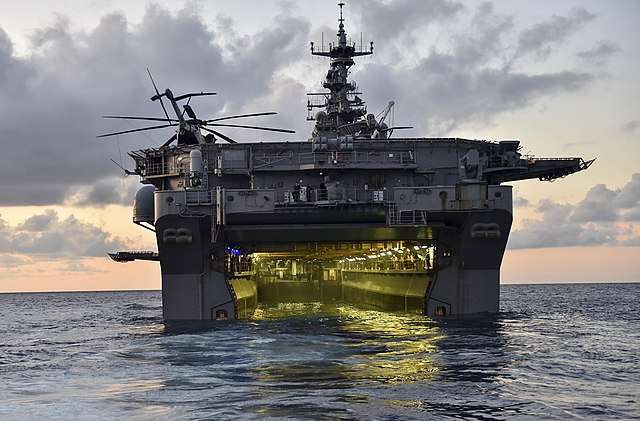The Wasp class ships provide the US Navy with an unrivalled ability to attack hostile shores around the world. These were the first ships specifically designed to operate both the AV-8B Harrier II and a complement of LCAC hovercraft. At the time of their introduction these were the largest amphibious assault vessels in the world. Currently only the new America class ships are larger.
The Wasp class is a follow-on from the Tarawa class and its ships share the same basic hull and engineering plant. However, the bridge is two decks lower than the LHAs (Landing Helicopter Amphibious) and the command, control and communications centers are inside the hull where they less easy to disable. To facilitate landing and recovery operations, the ships can ballast some 15 000 tons of sea water for trimming.

Capable of embarking a 2 000-strong marine expeditionary unit, the Wasp class can land its troops on the beach using its own landing craft, or deliver them inland via helicopters (a manoeuvre known as vertical envelopment). Each Wasp class can accommodate up to three LCACs or twelve LCMs in the 81 m x 15.2 m well deck. In total, 61 AAVs (Amphibious Assault Vehicles – the AAV7A1) can be shipped aboard, 40 stowed in the well deck and 21 in the upper vehicle storage area.
The flight deck has nine landing spots for helicopters and up to 42 CH-46 Sea Knights can be operated; the class can also deploy AH-1 SeaCobra attack helicopters or other transports such as the CH-53E Super Stallion, UH-1N Twin Huey or the multi-purpose SH-60B Seahawk. The Wasp class can operate six to eight AV-8B Harrier IIs in the combat role, but can support up to 20. There are two aircraft elevators, one amidships on the port side, the other to starboard, abaft the island. When the ships pass through the Panama Canal these lifts have to be folded inboard.

The composition of the air group depends on the mission. The Wasp class can function as aircraft carriers, operating 20 AV-8Bs in the sea control role, plus six ASW helicopters. For amphibious assault, a typical group consists of six AV-8Bs, four AH-1W Super Cobra attack helicopters, 12 CH-46 Sea knights, nine CH-53 Sea Stallions or Super Stallions and four UH-1N Twin Hueys. Alternatively, it can also operate 42 CH-46s.
The Wasp-class ships are designed to carry a balanced force of combat vehicles, including five M1 Abrams main battle tanks, 25 AAV7A1 armored personnel carriers, eight M198 155 mm towed guns, 68 lorries and a dozen or so other support vehicles. They can transport and land ashore all manner of equipment and vehicles. Monorail trains moving at up to 183 m per minute deliver cargo from the storage areas to the well deck, which opens to the sea through gates in the stern. Each ship also features a 600-bed hospital with six operating theatres, so reducing an amphibious task force’s dependence on medical facilities ashore.

The Wasp class has been replacing the older LHAs since the mid-1990s. USS Bataan was built by pre-outfitting and modular construction techniques. Subassemblies were brought together to produce five hull and superstructure modules. These modules were then joined together on land. The result of this construction technique was that the ship was three-quarters complete on launch. Bataan is the first amphibious assault ship designed from the outset to accommodate female personnel, both in the crew and Marine contingent. Full accommodation for up to 450 female officers, enlisted personnel and troops is provided on the vessel.
The last three ships of the class have cost an average of $750 million each. The US Navy planned for a 12-strong Amphibious Ready Group (ARG) to be deployed by 2010, when the first Tarawa class vessel became 35-years-old. The last ship of the Wasp class, the USS Makin Island, became a base for a new design of America class amphibious assault ships. The first ship of the America class was commissioned in 2014. Eventually these new ships will replace the ageing Tarawa class vessels.

In 2020 the USS Bonhomme Richard caught fire during shipyard repairs. It took 4 days to extinguish the fire. The ship was severely damaged. It was estimated that repairs will take 7 years and will cost an estimated $2.5 billion to 3.2 billion. It was not feasible to repair the damage. The US Navy decided to decommission and scrap the ship.
<Source:http://www.military-today.com/navy/wasp_class.htm>